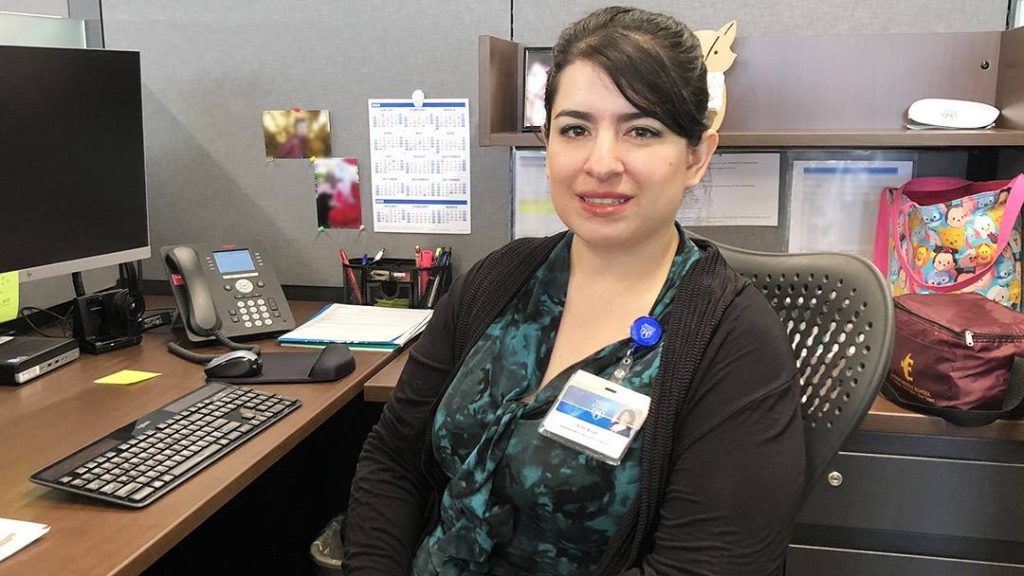
Erin Ayub spent months in a medically induced coma as her Mayo Clinic care team worked to fight off a rare and dangerous form of encephalitis. Today, Erin has made a remarkable recovery, and now as a Mayo staff member, she's eagerly working to help further the mission of the health care organization that saved her life.
From the outside looking in, Erin Ayub, an administrative assistant at Mayo Clinic in Arizona, appears to be a healthy 29-year-old woman. To see her now, no one would guess that she once spent months in the hospital battling through a rare autoimmune disease.
For a time, it wasn't clear if Erin would survive. But with the expert care of her Mayo Clinic team, she did. Now Erin is giving back to the place that saved her life eight years ago.
Puzzling symptoms
In 2011, Erin was a college senior working toward her bachelor's degree in business administration with a concentration in computer information systems. She lived in El Paso, Texas, with her parents and brother. In her free time, Erin led an active life as a musician and kickboxer. She also enjoyed cosplay — performance art that involves dressing up as a character from a movie, book, television show or video game.
While on a family vacation that year, Erin began to feel nauseated, and she started acting differently. She woke up earlier than usual, experienced brain fog and continued to battle bouts of nausea. Erin's symptoms continued for several months. Then her health declined further during finals weeks when she went to take an exam and struggled to fill in the first blank.
"I couldn't remember how to write my name," Erin says. "I knew my name. But to actually write it? I couldn't."
"I vaguely have a memory of being in a stretcher, leaving my house with flashing red and blue lights. That's the last thing I remember."
Erin Ayub
Her mother, Liz, thought Erin's symptoms could be due to stress during finals season. But the oddities continued when Erin walked around the house and turned lights on and off without cause. Liz describes it as "a zombie state." Then one December night, when her mother was helping her to bed, Erin began to have seizures.
"I vaguely have a memory of being in a stretcher, leaving my house with flashing red and blue lights," Erin says. "That's the last thing I remember."
Erin was rushed to a nearby hospital, where her condition puzzled doctors. Erin continued to experience seizures throughout her time there, flatlining during one of them. After that, doctors put Erin in a medically induced coma and recommended sending her to Mayo Clinic.
Rare condition identified
Erin was airlifted to Mayo Clinic Hospital in Arizona while on life support. When she arrived, her care team ran tests and diagnosed her with a rare autoimmune neurologic disease that affects the brain called anti-NMDA (N-methyl-d-aspartate) receptor encephalitis.
Over the course of this disease, the body attacks NMDA receptors with antibodies. "The NMDA receptor is a receptor on the brain that we use for neurotransmitters," explains Matthew Hoerth, M.D., a Mayo Clinic neurologist and a member of Erin's care team. "If you're attacking that transmitter specifically, you're not able to process information from one cell to the next, and that can lead to seizures and cognitive disturbances."
Erin's diagnosis came on the heels of the disease's initial discovery, and little is known about the condition even today. At the time of Erin's diagnosis, few case series had been published about it. Erin says she was estimated to be the 600th patient diagnosed. Dr. Hoerth says this number is fairly low only because doctors are discovering the anti-NMDA antibodies now. He says there is a possibility that more patients have the disease but have gone undiagnosed.
For her first several months at Mayo, Erin remained in a coma, and she had nonstop seizures. During that time, her care team did everything in its power to save her life. Erin was given several immunosuppressant medications to prevent her immune system from creating more anti-NMDA antibodies. She also had an ovary resection. In an attempt to ease her seizures, Erin was put on a strict ketogenic diet that cut out all carbohydrates, even those in her shampoo.
"It was highly specialized," Liz says. "The team met every day to determine what type of medication changes were done because they had to adjust her feeding based on the medication."
The hope was that if ketones fueled Erin's brain instead of glucose, the seizures would stop. Whether the treatment worked is difficult for doctors to determine, but Erin stopped seizing as often.
"You have a couple of choices. Either you fall apart or you pull together. And we were lucky that we pulled together."
Liz Ayub
Finally putting a name to her daughter's condition was a relief for Liz, but Erin's situation was serious. Several times, doctors prepared her family to expect the worst. They refused to give up, however, and banded together in unwavering support for Erin. During her daughter's hospital stay, Liz lived in Phoenix with Erin full time. Erin's father, a professor at El Paso Community College, took a bus to Phoenix every weekend and headed back in time to teach during the week. Erin's younger brother, an incoming college freshman at the time, held down the fort in El Paso. Dr. Hoerth credits Erin's recovery in part to her supportive family.
"You have a couple of choices," Liz says. "Either you fall apart or you pull together. And we were lucky that we pulled together."
It wasn't only her immediate family who rallied around Erin. Mayo Clinic staff also gave her their full support. "I consider so many people there family, not caregivers," Liz says.
The road to recovery
With treatment keeping her seizures under control, Erin's team felt comfortable bringing her out of the medically induced coma. When she woke up, Erin recalls that it felt like she had taken a long nap. In reality, she had been in a coma for eight months, and she needed to relearn how to do everything from eating to speaking.
"When I woke up, I had to start from scratch," she says. "It's like being a toddler all over again."
Having a passion for writing and being an avid reader, Erin quickly recovered her reading and writing skills, communicating with her family through a whiteboard. When she was discharged from the hospital, Erin continued outpatient rehabilitation for a few months at a skilled nursing facility in Phoenix, where she received speech, physical and occupational therapy.
"Erin, even though she didn't realize it at the time, is a fighter. This is a remarkable recovery. This does not happen often."
Matthew Hoerth, M.D.
Erin then returned to Mayo, where she had surgery for a back ulcer and entered the acute rehabilitation program. In the program, Erin worked on her mobility, first using a wheelchair and then a walker after a month. After that, she spent another year undergoing outpatient rehabilitation at a neuro-rehabilitation facility in El Paso.
"Erin, even though she didn't realize it at the time, is a fighter," Dr. Hoerth says. "This is a remarkable recovery. This does not happen often."
At the end of 2013, Erin decided it was time to go back to school. Her mother suggested trying one class a semester, but Erin finished the seven remaining classes for her major in just two semesters. Not only did she finish all her classes, Erin went on to earn master's degree in English and creative writing. She also picked up kickboxing and cosplaying again, and she's received awards for her cosplaying in competitions.
And back to Mayo
In El Paso, Erin searched for a job after working at a local humane society, but nothing stuck out to her. With her Mayo experience still fresh in her mind, Erin found an opportunity as an administrative assistant at Mayo Clinic in Arizona. She sent in an application and received a job offer several weeks later.
The thought of moving away from home was daunting. But as Erin reflected on the care she received, she knew Mayo Clinic would take care of her again. Although in her new job she doesn't work with patients directly, Erin knows her work makes a difference.
"I schedule for a couple of administrators, and it's kind of giving back, even though it's indirect," Erin says. "If I make their jobs easier, then they can help make their team's job easier, and that trickles down. This has become a bit of a second home as much as I was here."
For Liz, Erin's job is a reminder of how far her daughter has come. "When Erin got the opportunity to work for Mayo, she was thrilled about it," Liz says. "I just thought: 'We've come full circle. Hopefully there's something positive there — something she can do to pay back what Mayo did for us.'"
Watch this video to learn more about Erin's story:
HELPFUL LINKS
- Learn more about encephalitis.
- Read about Mayo Clinic's Department of Neurology.
- Visit Mayo Clinic Hospital in Arizona.
- Explore Mayo Clinic.
- Request an appointment.







